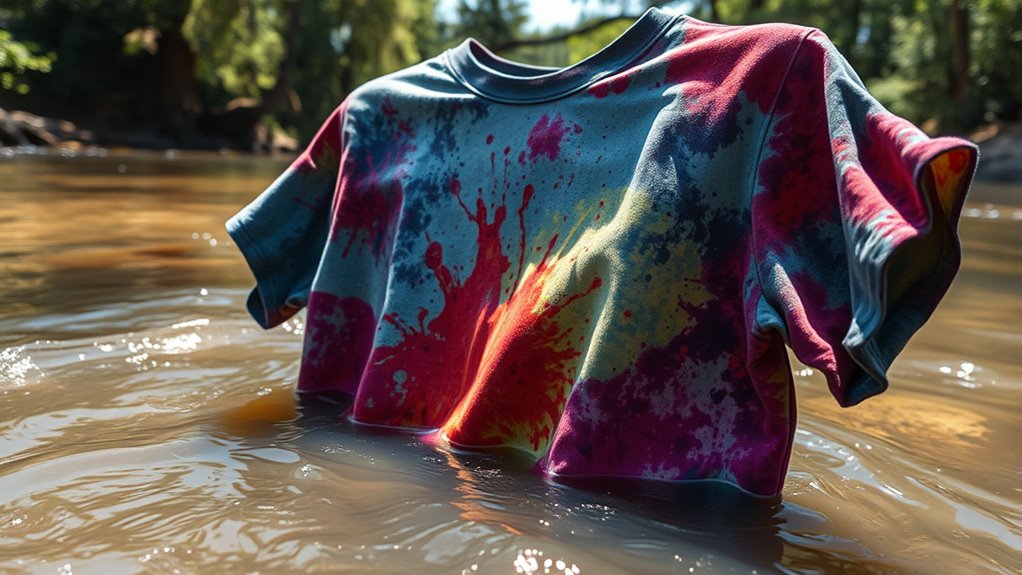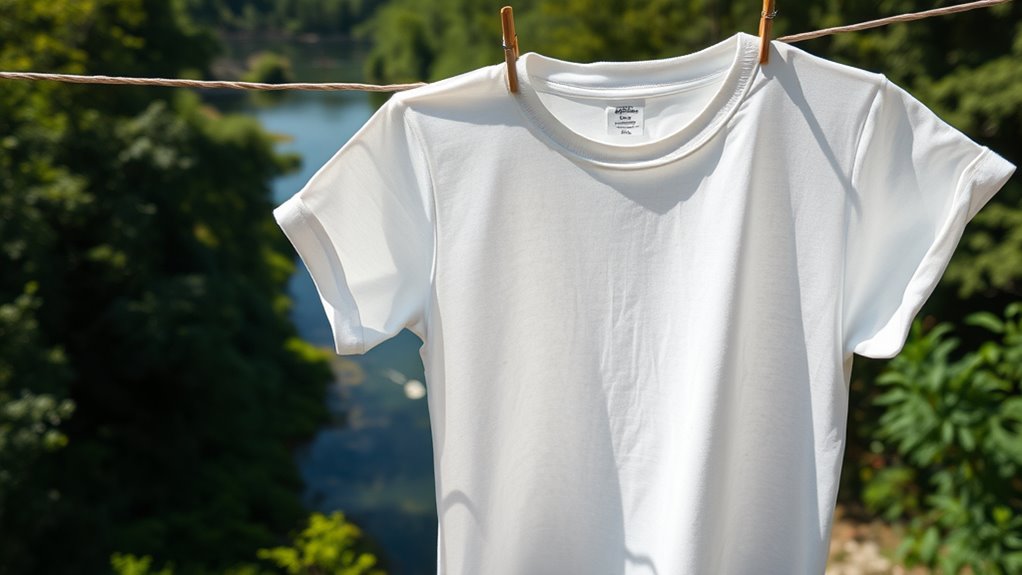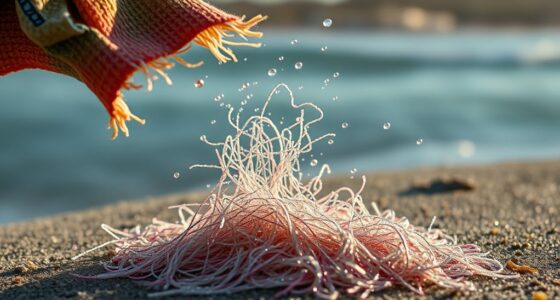Your T-shirt’s journey from raw materials to your wardrobe has a hidden environmental impact. Manufacturing fabrics like polyester releases greenhouse gases and pollutes air and water with toxic chemicals. During dyeing, massive water use and hazardous dyes often contaminate rivers, harming aquatic life and communities. These processes contribute to long-lasting pollution and climate change. If you want to uncover how your T-shirt affects ecosystems and what you can do to help, there’s more to discover below.
Key Takeaways
- The production of synthetic fibers like polyester releases greenhouse gases and toxic chemicals, contributing to environmental pollution.
- Dyeing processes use vast amounts of water and toxic dyes, often contaminating rivers with harmful chemicals.
- Untreated wastewater from textile factories pollutes water sources, harming aquatic ecosystems and communities relying on these waters.
- Energy-intensive fiber manufacturing and dyeing increase carbon emissions, impacting climate change and environmental health.
- Choosing eco-friendly fabrics and supporting sustainable brands can help reduce the hidden pollution footprint of your T-shirt.

Every time you buy a new T-shirt, you might not realize the environmental impact behind it. Behind the scenes, complex processes like fiber manufacturing and dyeing contribute considerably to pollution, often in ways that aren’t immediately visible. When fibers are produced, raw materials such as cotton, polyester, or blends are transformed into textiles through energy-intensive manufacturing. This stage can involve the use of toxic chemicals, especially if synthetic fibers like polyester are involved, which are derived from fossil fuels. The extraction and processing of these materials release greenhouse gases and pollutants into the air and water, setting the stage for environmental harm long before your T-shirt even reaches your closet.
Fiber production involves energy-intensive processes and toxic chemicals that harm the environment before your T-shirt reaches your wardrobe.
Once the fiber manufacturing is complete, the dyeing processes take center stage. Dyeing is notorious for its heavy water consumption and the release of hazardous chemicals. Many dyes contain toxic substances that, if not properly managed, end up in wastewater. In many cases, wastewater from dyeing facilities is discharged directly into nearby rivers or streams, contaminating water sources that communities depend on. This not only harms aquatic life but also affects agricultural irrigation and drinking water supplies downstream. The chemicals used in dyeing are often persistent, meaning they don’t break down easily and can accumulate in ecosystems over time.
You might think that buying a stylish, colorful T-shirt is harmless, but the truth is that the vibrant hues we see are the result of these chemical-intensive dyeing processes. Many factories cut corners by dumping untreated wastewater or using dyes with high environmental footprints. This pollution seeps into rivers, affecting fish, plants, and the health of local populations who rely on these water sources. Additionally, the energy used during fiber manufacturing and dyeing contributes to carbon emissions, further fueling climate change. The entire lifecycle of your T-shirt—from raw material extraction to production—can have a substantial environmental footprint.
While it’s easy to focus on the garment’s appearance or price, understanding these behind-the-scenes processes makes it clear that every T-shirt you buy has a story of resource use and pollution behind it. Making more sustainable choices, like opting for organic cotton or recycled fabrics, can help reduce this impact. Supporting brands that prioritize eco-friendly fiber manufacturing and cleaner dyeing processes encourages industry change. Ultimately, being aware of how your T-shirt is made helps you understand that your clothing choices are connected to environmental health, and small actions on your part can contribute to a cleaner, greener planet.
Frequently Asked Questions
How Can I Identify Eco-Friendly T-Shirts?
To identify eco-friendly T-shirts, check the fabric dyes used—they should be low-impact or natural dyes that reduce water pollution. Look for eco label certifications like GOTS or OEKO-TEX, which verify sustainable and safe manufacturing practices. You can also research the brand’s commitment to sustainability, ensuring they prioritize eco-friendly materials and ethical production. These steps help you choose T-shirts that are better for the environment.
Are Synthetic Fibers More Harmful Than Natural Ones?
Synthetic fibers are generally more harmful than natural ones because they shed microfibers during washing, which contributes to water pollution. These microfibers are tiny and hard to filter out, leading to microfiber shedding that pollutes rivers and oceans. Additionally, synthetic fibers have low fiber biodegradability, meaning they take centuries to break down, unlike natural fibers that decompose more quickly and are less damaging to the environment.
What Brands Prioritize Sustainable T-Shirt Production?
You can choose brands that prioritize sustainable t-shirt production by researching their dyeing processes and labor practices. Look for companies that use eco-friendly dyes, reduce water use, and guarantee fair wages. Brands like Patagonia, Everlane, and Tentree focus on transparency, minimizing environmental impact, and ethical labor practices. By supporting these brands, you help promote sustainability and reduce pollution caused by harmful dyeing techniques and unfair working conditions.
How Effective Are Laundry Additives in Reducing Microfiber Pollution?
Imagine tiny fibers escaping your laundry like a microscopic tornado, polluting rivers! Laundry additives can help reduce microfiber shedding, but they’re not magic. Some work by capturing fibers, while others strengthen fabric fibers to prevent breakage. Using specialized laundry detergent with microfiber filters can markedly cut down pollution, but don’t rely solely on additives. Combining them with eco-friendly practices is your best shot at stopping this hidden environmental disaster.
Can Washing Machine Filters Prevent Fiber Release?
Washing machine filters can considerably prevent fiber release by capturing microfibers during laundry. Microfiber filtration is a key feature of many washing machine upgrades, making them more eco-friendly. When you install these filters, you actively reduce microfiber pollution, helping protect rivers and oceans. Regular maintenance guarantees peak performance, so investing in a filter-equipped washing machine is a practical step toward sustainable laundry habits.
Conclusion
So, next time you toss on that T-shirt, remember it’s quietly weaving pollution into our rivers’ stories. Your simple choice can fuel a hidden storm beneath the surface, turning vibrant waterways into silent victims. By being mindful, you hold the power to break the chain and let cleaner waters flow. Every small step is like a drop in a vast ocean—together, you can make waves of change and clear the path for a healthier planet.









